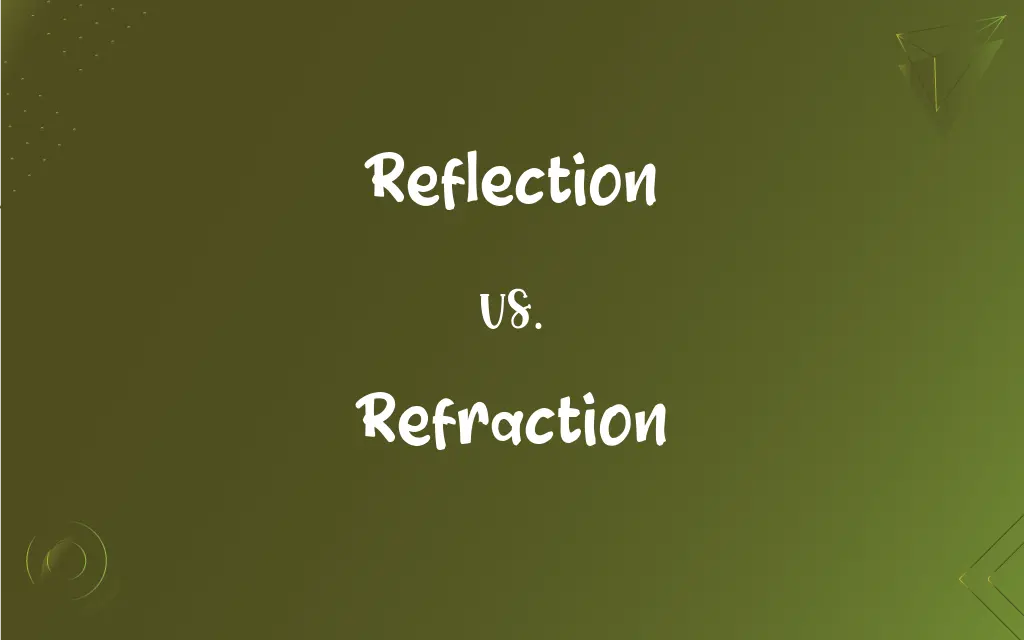Reflection vs. Refraction: What's the Difference?
Edited by Janet White || By Harlon Moss || Updated on August 20, 2024
Reflection is the bouncing back of light from a surface; refraction is the bending of light as it passes from one medium to another.

Key Differences
Reflection and refraction are fundamental concepts in the study of optics and light. Reflection refers to the phenomenon where light waves bounce back after striking a surface. This is why we can see our faces in a mirror; the light from our faces strikes the mirror and is reflected back to our eyes. In contrast, refraction describes the bending of light waves as they pass from one transparent medium into another. This is the principle behind lenses and how they focus or disperse light.
In everyday experiences, reflection and refraction play vital roles. When light hits a calm pond or lake, the reflection of trees, clouds, and other surroundings on the water's surface is a visual manifestation of reflection. On the other hand, when we look at a straw in a glass of water, it appears bent at the surface of the water due to refraction, as light travels differently through air and water.
From a technical standpoint, reflection can be categorized into two types: specular reflection, which is reflection from smooth surfaces like mirrors, and diffuse reflection, which is reflection from rough surfaces like walls. Refraction, on the other hand, is governed by Snell's law, which relates the angles of incidence and refraction to the refractive indices of the two media involved.
In applications, both reflection and refraction find immense utility. Telescopes, for instance, utilize reflection through mirrors to gather and focus light from distant celestial objects. Eyeglasses, meanwhile, employ refraction to correct vision by bending light in a manner that compensates for visual imperfections.
To sum it up, while reflection concerns the rebounding of light off surfaces, refraction deals with the change in light's direction when transitioning between different mediums.
ADVERTISEMENT
Comparison Chart
Definition
Bouncing back of light from a surface
Bending of light between two mediums
Associated Law
Law of Reflection
Snell's Law
Example
Mirror image
Bent straw in a glass of water
Occurs at
Surface of a medium
Boundary between two transparent mediums
Application
Mirrors, telescopes
Lenses, optical fibers
ADVERTISEMENT
Reflection and Refraction Definitions
Reflection
The return of light after striking a surface.
The clear water provided a perfect reflection of the sky.
Refraction
The change in direction of light as it passes from one medium to another.
Refraction causes the appearance of a broken straw in water.
Reflection
An image seen in a mirror or other shiny surface.
She checked her reflection in the mirror before leaving.
Refraction
The measure of the bending of light in various materials.
The refraction of diamonds gives them their sparkle.
Reflection
An effect produced by an influence.
The state of the economy is a reflection of global events.
Refraction
A phenomenon of sound wave direction change.
Refraction of sound can influence how we perceive its source.
Reflection
A remark or comment, especially a critical one.
The article was a negative reflection on the company's ethics.
Refraction
The determination of the refractive power of the eye.
The optometrist tested for refraction to prescribe glasses.
Reflection
Serious thought or careful consideration.
After some reflection, he decided to apologize.
Refraction
A process in meteorology affecting wave propagation.
Atmospheric refraction can distort distant objects on the horizon.
Reflection
The act of reflecting or the state of being reflected.
Refraction
The deflection of a wave, such as a light or sound wave, when it passes obliquely from one medium into another having a different index of refraction.
FAQs
What causes the bending in refraction?
The change in speed of light when it moves from one medium to another causes refraction.
Why do objects look bent in water?
This optical illusion is caused by the refraction of light as it moves from air to water.
Are reflection and refraction exclusive phenomena?
No, both can occur simultaneously, like light reflecting off water and also refracting through it.
Is reflection responsible for the images in mirrors?
Yes, mirrors produce images due to the reflection of light.
Why is reflection important in optics?
Reflection is key in devices like mirrors and telescopes, aiding in image formation.
How does refraction affect astronomical observations?
Refraction can cause celestial objects near the horizon to appear higher than they are.
Can reflection be observed on any surface?
While most surfaces reflect light, the clarity of the reflection depends on the surface's smoothness.
Does the angle of incidence affect reflection?
Yes, the angle of incidence equals the angle of reflection on smooth surfaces.
How do corrective lenses work?
They use refraction to bend light rays, helping the eye to focus images properly.
Why does a prism separate white light into colors?
This is due to refraction; different colors bend by different amounts in the prism.
Can reflection produce color effects?
Yes, thin-film interference on surfaces can cause colorful reflection patterns.
Why is the sky blue and sunsets red?
This is due to the refraction and scattering of sunlight in the atmosphere.
Is refraction responsible for rainbow formation?
Yes, rainbows result from refraction, reflection, and dispersion of light in water droplets.
Are the laws of reflection and refraction universal?
These laws apply widely to waves, including light and sound.
Can reflection occur in transparent materials?
Yes, surfaces of transparent materials, like glass or water, can reflect light.
Is the bending of light in lenses due to refraction?
Yes, lenses utilize refraction to focus or disperse light.
Why do mirrors reverse images left to right but not top to bottom?
This is due to the orientation of reflection; it's a lateral inversion, not a vertical one.
Can reflection be diffused?
Yes, rough surfaces scatter light in many directions, causing diffuse reflection.
How does refraction influence underwater vision?
Refraction makes objects underwater appear closer and larger than they actually are.
Can sound undergo refraction?
Yes, sound can refract, especially when moving through varying temperature or density conditions.
About Author
Written by
Harlon MossHarlon is a seasoned quality moderator and accomplished content writer for Difference Wiki. An alumnus of the prestigious University of California, he earned his degree in Computer Science. Leveraging his academic background, Harlon brings a meticulous and informed perspective to his work, ensuring content accuracy and excellence.
Edited by
Janet WhiteJanet White has been an esteemed writer and blogger for Difference Wiki. Holding a Master's degree in Science and Medical Journalism from the prestigious Boston University, she has consistently demonstrated her expertise and passion for her field. When she's not immersed in her work, Janet relishes her time exercising, delving into a good book, and cherishing moments with friends and family.
































































